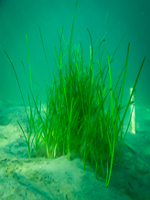ABSTRACT
Along the Swedish west coast over 50% of the Zostera marina (eelgrass) meadows have vanished since the 1980’s. As environmental conditions are improving, interest to restore lost habitats are growing, but methods are lacking for restoration of eelgrass beds at high latitudes where long winters create special challenges for restoration.
We assessed if seed planting could be used for large-scale restoration, with the aims to identify the major causes of seed and seedling loss and methods to increase the restoration success. In the laboratory, we identified optimal conditions for long-term seed storage and demonstrated that eelgrass seeds can be successfully stored for 8 months before being planted in the spring.
However, field studies did not find an increased seedling establishment in seeds planted in the spring of 2013 compared to those planted in the fall of 2012. Field results suggest that the main processes responsible for the seed loss were seed predation from crabs, seed transport by currents and bioturbation by lugworms, while the main process affecting shoot development was light availability and physical disturbance.
Covering the seeds with a layer of sand increased seedling establishment 2-6 times compared to uncovered seeds, probably by reducing seed-predation and seed transport and could potentially be developed as a method to reduce losses during restoration. In addition, positive feedbacks mechanisms (i.e. sediment resuspension and drifting macroalgae mats) may also prevent natural recovery and restoration success. However, high seed-loss (on average 98.6%) and high shoot mortality pose a challenge that need to be addressed before restoration using seeds can be recommended for large-scale restoration.













